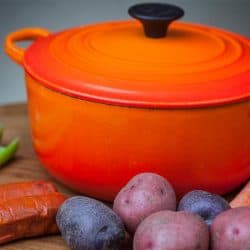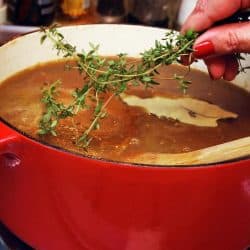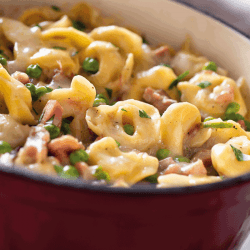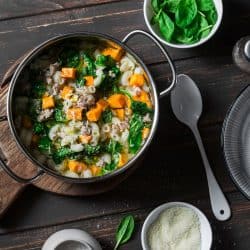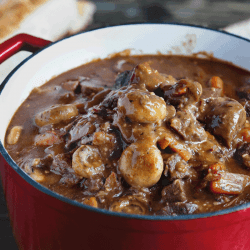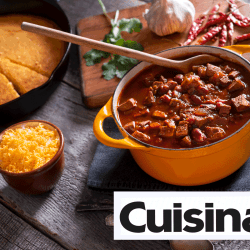If you have ever wondered what the difference between a stock pot and a soup pot is, you are not alone. These types of cookware not only resemble one another, but you can also use stock pots and soup pots interchangeably. To help with this kitchen question, we have compared these two pieces of cookware to get the best answer for you.
Stock pots have a few key differences in comparison to soup pots such as:
- Stock pots have tall, narrow sides designed to hold larger volumes of liquid versus the shorter, widened sides of a soup pot, which is designed to hold dense ingredients.
- Stock pots have thin bottoms (stainless steel, copper, or aluminum) that conduct heat quickly and evenly to promote a rapid boil. Soup pots have heavy-duty bases (tri-ply stainless/aluminum) designed to conduct heat consistently yet prevent burning during slow simmers.
- Stock pots equipped with grip-able, double handles are great for easy lifting and pouring. Soup pots tend to have one, long-extended handle.
Now that you know the differences between stock pots and soup pots, you will want to keep reading to learn how you can use each type of cookware. We will also mention several alternatives to use if you do not already have a stock pot in your kitchen.

What is the Difference Between a Dutch Oven and a Stock Pot?
Sometimes you might hear a stock pot referred to as a Dutch oven. The stout, heavy-duty Dutch oven is an equally versatile piece of cookware, although it has some significant differences from a stock pot like:
- Size and shape: Dutch ovens have short sides and diverse forms such as rectangular, circular, and oval.
- Material: constructed from either cast iron (seasoned or enameled) or enameled ceramic, Dutch ovens are heavy. This cookware will heat slowly, but maintain an even temperature throughout the dish.
- Oven safe: use a Dutch oven for baking, broiling, and roasting.
- Cost: Dutch ovens tend to be more expensive than stock pots.
Dutch ovens are available in a variety of sizes, from 1.5-quarts to 13-quarts. With the added advantage of either oven or stovetop use, the Dutch oven is an excellent choice for making one-pot meals. It can also be a colorful addition to your kitchen, like this Caribbean Blue featured by Lodge.
Click here to find this on Amazon.
What Can I Use Instead of a Stock Pot?
If you don’t already have a stock pot, don’t worry! Odds are your kitchen is already equipped with cookware that you can use as an alternative. The next time you find yourself in need of a stock pot, try using any of these pots instead:
- Dutch oven.
- Soup pot.
- Large saucepan.
Can You Use a Stock Pot to Make Soup?
A stock pot is an excellent choice of cookware to use for making soup. The design is for making broth from bones or vegetables: the base of most soups. Because it enables a quick boil throughout a large quantity of liquid and is large enough to contain whole vegetables, large beef bones, and whole poultry, the stock pot is a classic soup vessel.
Just keep a close watch and occasionally stir, particularly when making thick soups, because the ingredients at the bottom of the stock pot’s thin base can burn quickly.
Using a small, 4-quart stock pot is ideal for soups. This size will serve between six and eight, 1-cup servings, so it is perfect for serving large families or dinner guests. The heat-proof, Bakelite handles on this stock pot by CHEF let you stir and pour with ease.
Click here to find this on Amazon.
Go big to feed a crowd, or for making bone or vegetable stocks by using an 8-quart stock pot for your soups. This stock pot by Calphalon has a tri-ply bottom so you can worry less about soups burning while you keep them at a slow, long simmer for even cooking.
Click here to find this on Amazon.
What Can I Use a Stock Pot For?
Stock pots are incredibly versatile and come in a variety of sizes from 4-quarts to 30-quarts. These pots are a great addition to any kitchen because you can use stock pots to make your favorite recipes by using a variety of cooking methods. Use a stock pot on the stovetop to make:
- Bone or vegetable broth (or stock).
- Slow-cooked foods.
- Steamed foods.
- Boiled foods.
- Preserved foods.
You will find so many delicious recipes that can be cooked in stock pots like tomato sauce, spaghetti, chicken and dumplings, curry, mashed potatoes, gumbo, and risotto, just to name a few. For even more great ideas on how to use your stock pot, check out our blog, “What Can I Cook in a Stock Pot?”
What Can I Use a Soup Pot For?
You can use a soup pot interchangeably with a stock pot, so there is no need to equip your kitchen with both. Cook soup, broth, chili, pasta, curry, steamed vegetables, rice, and so much more when you select the right size soup pot for the job.
This 4-quart soup pot by Cuisinart is handy to have in the kitchen for making soups, as well as side dishes like rice, pasta, or steamed vegetables.
Click here to find this on Amazon.
Larger soup pots like Update International’s 6-quart pot are great for cooking chili, curry, and stew if serving the entire family.
Click here to find this on Amazon.
Check out our blog, “How Big of a Stock Pot Do I Need?” to get all of the details on sizing your soup or stock pot for various recipes and serving yields.
Final Thoughts
It can be confusing to select cookware, particularly when different types of pots resemble one another. But, now that you know the differences between a stock pot and a soup pot, you can be sure to grab the right pot for your kitchen.
Remember, especially if you have minimal storage space in your kitchen, that stock pots and soup pots can be used interchangeably. So, you can select one for many recipes and cooking techniques.






